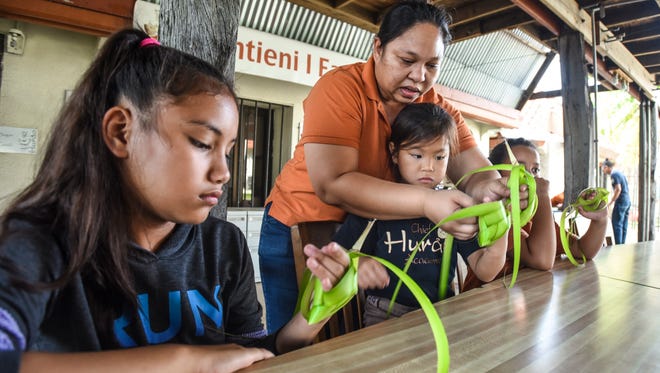Options for learning to speak Chamorro

With the Chamorro language spoken less with each generation since World War II, it’s more important now than ever for the people of Guam to learn it, keep it alive and pass it on to future generations.
Mes Chamorro is the perfect time to get started and practice speaking. Even if it feels awkward or embarrassing to pronounce the words, or if you get the accent wrong at first, it doesn’t hurt to give it a try.
To get your kids immersed in Chamorro culture and language, the Chief Huråo Academy offers after-school and summer programs in Chamorro Village, near the Guam Fishermen’s Co-op.
Kids can enter the after-school program, Tiempon Minagof, from 3 to 6 p.m. Mondays through Fridays. For rates and registration, message their Facebook page or contact Angelana Sablan at 472-5858.
At Tiempon Minagof, instructors hold lessons on Chamorro language, culture and arts. Children ages 4 to 13 — or as soon they’re potty trained — can join in.
“It’s full-on culture, not just language,” says Frankie “Ma’åse” Casil, Chief Huråo Academy’s program coordinator. “When kids come to Huråo, the first thing they hear is Chamorro when they enter the doors.”
Chief Huråo Academy continues this cultural immersion through their summer program, Tiempon Somnak, from June to early August.
They also offer Chamorro classes for parents twice a week, which is included in the cost of Tiempon Minagof.
“It’s an effort that everybody needs to put into — not just kids, but parents,” Casil says.

Learning for adults
The most practical and natural way to get better at Chamorro is to speak it with your nana and tata or other family members at home.
But for those who don’t have native speakers in their household, there are plenty of other ways to learn.
For adults who want to learn Chamorro, Chief Huråo Academy offers the Cho’gue’ Ha’ program.
Those interested go through an interview process first, to give the Huråo staff a sense of their dedication to learning the language.
Casil says you can walk in not knowing any Chamorro and end up speaking and understanding fluently after a year. It all depends on your level of commitment.
Adults who want to develop their Chamorro-speaking skills can also enroll in classes at the University of Guam or Guam Community College.
If you prefer learning on your own or don’t have time for sit-in courses, check out LearningChamorro.com. The platform is free and comes with lessons, an online dictionary, grammar resources, dialogues to practice and media examples of published Chamorro language to study.
Chamorro language program starting in San Diego
‘The most rewarding journey’
University of Guam student Mariana Gabriel, 23, started taking classes at Huråo in September 2016. Gabriel returned to Guam for UOG’s Chamorro Studies program, after living and working in San Francisco for a few years. She plans to study indigenous law, but first wanted to get a foundational understanding of Chamorro culture on an academic level.
“It’s paramount to know the language before taking any classes in culture or history,” she says. “Having a basis in language gives you a certain lens to look through.”
She enrolled in beginner’s Chamorro language courses, both at UOG and Huråo, to practice speaking every day. She went from having almost no knowledge of Chamorro, to being able to understand, write and speak it comfortably.
“Now my nana speaks to me in Chamorro before she speaks to me in English, and that feels really good,” she says. “It’s really rewarding.”
Gabriel says the comfortable environment at Huråo gave her the confidence and support she needed to speak regularly in Chamorro.
“I was super nervous about pronouncing and was so shy to speak it at first,” she says.
Now Gabriel makes it a point to speak to strangers she meets in Chamorro, at the level of proficiency she worked to gain over the past half year.
“It took months of working up the courage because I was so embarrassed about pronouncing something wrong,” she says. “It’s kind of a big hump to get over, especially because I don’t have any friends or anybody my age who can speak it fluently, so it’s really difficult to find people you can have a conversation with, and have them be able to correct you.”
Although she still stumbles with the language a bit, talking to new people in Chamorro and creating new connections makes it worthwhile.
“People are so surprised to hear me speak it to them,” she says. “They end up telling me their stories and giving me gifts. These beautiful interactions outweigh the uncertainty and nervousness of learning to speak.”
As her nana gets older, Gabriel feels a sense of urgency to learn how to speak more now than ever. She says having her grandma around to teach her the native tongue is an invaluable gift — which is infinitely better than having to use a dictionary or look up the grammar on her own.
“Sharing these conversations with her in Chamorro has been the most rewarding part of learning this language,” she says. “I want to reach a level of fluency while I can have these conversations with her, and she can teach the language to me in her own way.”
Gabriel feels the urgency to learn her ancestors’ language not only to grow closer to her nana, but because of its significance rooted in historical injustice.
“I think with being Chamorro and not being able to speak it, you want to bridge that cultural genocide that’s imposed on us,” she says. “We weren’t able to speak our language, our lands were taken away from us, stripped from us as Chamorros. Learning your language is taking back what’s yours. That motivation is something I never had before. Learning Chamorro is the most rewarding journey I’ve ever embarked on.”